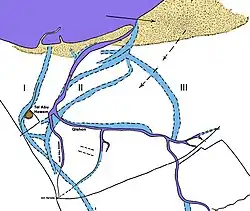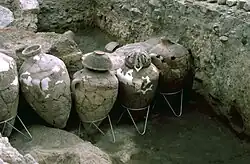Tell Abu Hawam
תל אבו הואם | |
 2001 expedition by the University of Haifa | |
| Location | Haifa Bay, Haifa, Israel |
|---|---|
| Region | Levant |
| Coordinates | 32°48′03″N 35°01′09″E / 32.80083°N 35.01917°E |
| Type | Tell |
| History | |
| Periods | Antiquity |
| Cultures | |
| Site notes | |
| Excavation dates | 1932 |
| Archaeologists | |
| Management | Israel Antiquities Authority |
Tell Abu Hawam is the site of a small city established in the Late Bronze Age (circa 1600 BCE) in the area of modern-day Haifa, Israel.[1] The sixth century BCE geographer Scylax described the city as being located "between the bay and the promontory of Zeus", by the latter meaning the northwestern extremity of Mount Carmel. It existed as a port city and a fishing village, and was moved to the site south of what is now the neighborhood of Bat Galim. The city eventually expanded into what is now the city of Haifa.
The site was excavated by a British expedition from 1929 to 1933.[2]
Archaeology
During the 1929-1933 British excavations, a black-glazed bowl of the "fish-plate" type was uncovered, featuring a Phoenician graffito scratched on its underside. It is suggested that the bowl may originate from the 4th or 3rd century BCE.[2]
-
.jpg) Tell Abu Hawam Plan 1932
Tell Abu Hawam Plan 1932 -
 Jars excavated from the site of Tell Abu Hawam
Jars excavated from the site of Tell Abu Hawam
See also
References
- ^ Balensi, Jacqueline (January 1985). "Revising Tell Abu Hawam". Bulletin of the American Schools of Oriental Research. 257: 65–74. doi:10.2307/1356819.
- ^ a b "Volume 5/Part 1 Galilaea and Northern Regions: 5876-6924", Volume 5/Part 1 Galilaea and Northern Regions: 5876-6924, De Gruyter, p. 692, 20 March 2023, doi:10.1515/9783110715774, ISBN 978-3-11-071577-4, retrieved 5 February 2024
Further reading
- Encyclopedia Judaica, Haifa, Keter Publishing, Jerusalem, 1972, vol. 7, pp. 1134–1139
- The New Encyclopedia of Archaeological Excavations in the Holy Land, Volume 5, article Abu Hawam p 1553